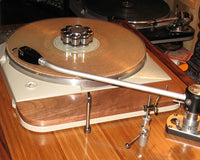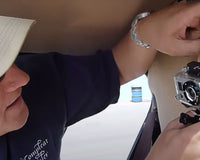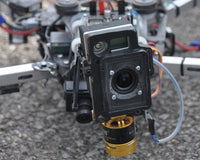Hey everyone, Ian here! I’m the polymer engineer and DIY maker on the team at Isolate IT Manufacturing. To say I’m excited is an understatement. For years, I’ve been obsessed with how materials can solve everyday problems, and I’ve spent countless hours in my workshop tinkering, building, and bringing ideas to life. Now, I get to embark on a new series with one of the most unique materials on the planet: Sorbothane®.
If you’ve found your way to our corner of the internet, you’re probably like me—a problem solver. Maybe you’re an audiophile chasing the purest sound, a 3D printing enthusiast battling for the perfect print, or a homeowner tired of that rattling washing machine. Whatever your challenge, you’re looking for a solution. And I’m here to tell you that in the world of shock and vibration, Sorbothane® is often the answer.
This post is the first in a new series where we’ll dive deep into the world of Sorbothane®. We'll explore what it is, where it came from, and why it’s the secret weapon in so many high-performance applications. Then, in the coming weeks, we’ll get our hands dirty and explore exactly how you can use it to solve real-world problems.
From Human Tissue to a Material Marvel
Our story begins not in a sterile corporate lab, but with the elegant complexity of the human body. In the late 1970s, materials scientist Dr. Maurice Hiles was inspired by the soft tissue in the human heel. He wanted to create a synthetic material that could mimic its incredible ability to absorb and safely dissipate impact energy.
After countless experiments, in 1982, he synthesized a unique, thermoset, polyether-based polyurethane. He called it Sorbothane®. What he had created was a true viscoelastic marvel.
So, what does "viscoelastic" actually mean? Let’s break it down.
-
Elastic materials are like a rubber band. When you apply force, they stretch and store that energy. When you let go, they snap back, releasing almost all of the energy. Think "bounce."
-
Viscous materials are like honey. When you apply force, they flow and dissipate the energy. They don’t return to their original shape. Think "splat."
Sorbothane® does both. It deforms under load like a liquid, but its solid molecular structure gives it a "memory" to return to its original shape. Critically, it does so slowly. That slow recovery is the magic. The energy from an impact or vibration doesn't get returned to the system as a bounce or a jiggle; it gets converted into a tiny, negligible amount of heat.
This is why Sorbothane® can absorb up to 94.7% of impact shock. It’s the reason a raw egg wrapped in Sorbothane® can survive a whack from a hammer, and why NASA trusted it to protect sensitive cameras during the violent vibrations of a Space Shuttle launch.
More Than Just a Squishy Pad: Sorbothane® vs. The World
You might be thinking, "Okay, it’s soft and absorbs shock. So do foam and rubber, right?" Not quite. This is where Sorbothane®'s superiority really shines.
-
vs. Rubber/Neoprene/Silicone: These materials are fundamentally elastic. They are great for isolating things, but they have a high rebound rate. They store and return energy, which can sometimes make vibrations worse. Sorbothane® has an extremely low rebound rate, meaning it kills vibration energy instead of just redirecting it.
-
vs. Foam: Foam products work by compressing tiny pockets of gas. Over time and with repeated impacts, the cell walls of these pockets break down. The foam "packs out," loses its cushioning ability, and stops working. Sorbothane® is a solid polymer. It doesn't rely on gas pockets, so it can perform flawlessly for millions of cycles without degrading.
This unique combination of shock absorption, vibration damping, and long-term stability in a single material is what makes Sorbothane® so special. It’s not just a bumper; it’s a complete energy management system.
Your Partner in Vibration Control
Here at Isolate IT, our journey started with a single problem: a rattling front-load washing machine. That led to the creation of our industry-leading Silent Feet. But soon, people just like you—engineers, makers, audiophiles, and DIYers—started asking for the raw Sorbothane® material to use in their own projects.
That’s how we became the premier global source for Sorbothane® parts and, more importantly, for information. We’re here to be your partner. We want to give you the tools and the knowledge to solve your own vibration challenges.
Get Ready to Build with Us!
This is just the beginning. Now that you understand the "what" and "why" of Sorbothane®, we’re going to get into the "how." In our upcoming blog posts, we will explore a ton of exciting applications, complete with step-by-step guides:
-
The Audiophile's Toolkit: How to use Sorbothane® hemispheres and sheets to decouple your turntable, speakers, and amps for a cleaner, tighter sound.
-
Perfecting Your 3D Prints: A deep dive into eliminating vibration artifacts (ghosting/ringing) to achieve unbelievably smooth and detailed prints.
-
Taming the Mechanical Keyboard: How to use Sorbothane® to achieve that perfect, deep "thock" sound and eliminate case ping.
-
And much more! We'll even look at quieting drones, building custom isolation platforms, and other projects submitted by you, our community.
I can’t wait to start this journey with you. Sorbothane® is a game-changing material, and the possibilities are limited only by our imagination.
Have a specific vibration problem you’re trying to solve? Drop it in the comments below! Let’s start the conversation.










